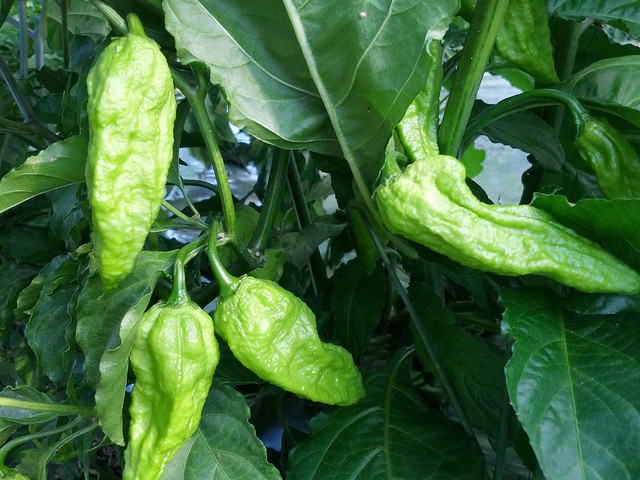So let me first apologize for the lack of cleanliness of my growing area. I got in way over my head with trying to manage 3 seperate gardens, a greenhouse, two websites, a farmer's market and a full time job.
These are the plants in which I am testing silver plastic mulch from Harris Seeds. There was some University reasearch on this method and increased yields in peppers. The main purpose of it is to confuse aphids and thrips by not providing them a shady place to reproduce. So far I haven't found a single aphid on these plants so I am pretty happy with the result. I won't know for sure about the increased production until the end of the year, but just eyeballing it, I would say there are 10% more pods on these plants, with the exception of the TS Butches which are dropping blossoms.
May 30th
From right to left - Yellow bhuts, Chocolate Bhuts, TS Butch T

IMG_20120530_064143 by GhostPepperStore.com, on Flickr
June 25th
Red Bhuts

IMG_20120625_064445 by GhostPepperStore.com, on Flickr
Yellow Bhuts

IMG_20120625_064425 by GhostPepperStore.com, on Flickr
Chocolate Bhuts

IMG_20120625_064412 by GhostPepperStore.com, on Flickr
TS Butch T

IMG_20120625_064401 by GhostPepperStore.com, on Flickr
Chocolate Bhuts Close Ups

IMG_20120624_080540 by GhostPepperStore.com, on Flickr

IMG_20120624_080454 by GhostPepperStore.com, on Flickr
These are the plants in which I am testing silver plastic mulch from Harris Seeds. There was some University reasearch on this method and increased yields in peppers. The main purpose of it is to confuse aphids and thrips by not providing them a shady place to reproduce. So far I haven't found a single aphid on these plants so I am pretty happy with the result. I won't know for sure about the increased production until the end of the year, but just eyeballing it, I would say there are 10% more pods on these plants, with the exception of the TS Butches which are dropping blossoms.
May 30th
From right to left - Yellow bhuts, Chocolate Bhuts, TS Butch T

IMG_20120530_064143 by GhostPepperStore.com, on Flickr
June 25th
Red Bhuts

IMG_20120625_064445 by GhostPepperStore.com, on Flickr
Yellow Bhuts

IMG_20120625_064425 by GhostPepperStore.com, on Flickr
Chocolate Bhuts

IMG_20120625_064412 by GhostPepperStore.com, on Flickr
TS Butch T

IMG_20120625_064401 by GhostPepperStore.com, on Flickr
Chocolate Bhuts Close Ups

IMG_20120624_080540 by GhostPepperStore.com, on Flickr

IMG_20120624_080454 by GhostPepperStore.com, on Flickr


